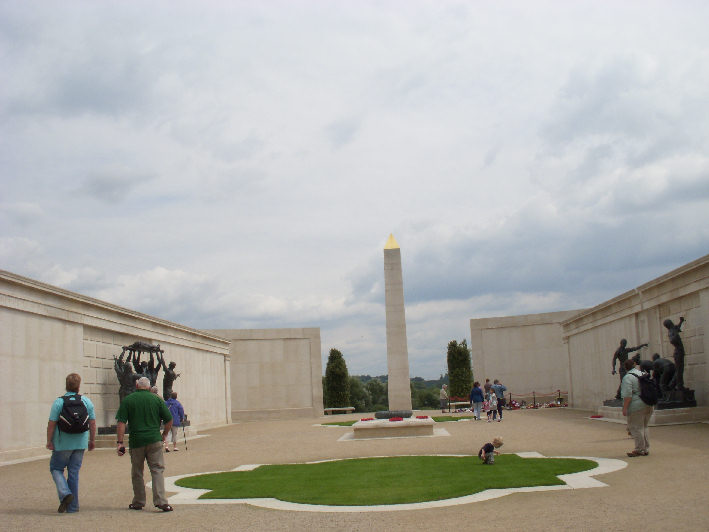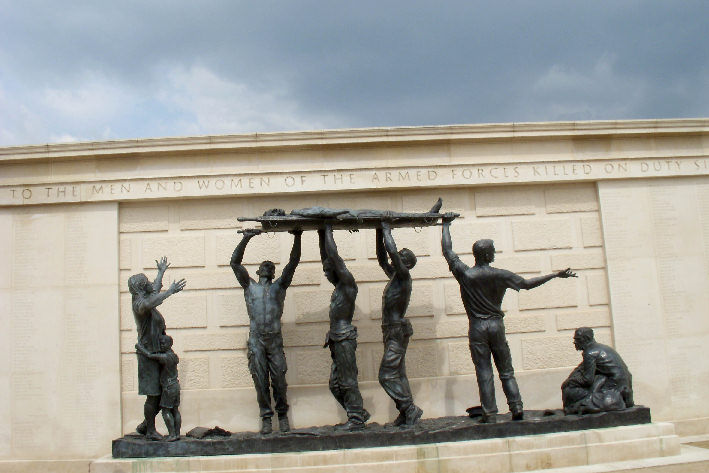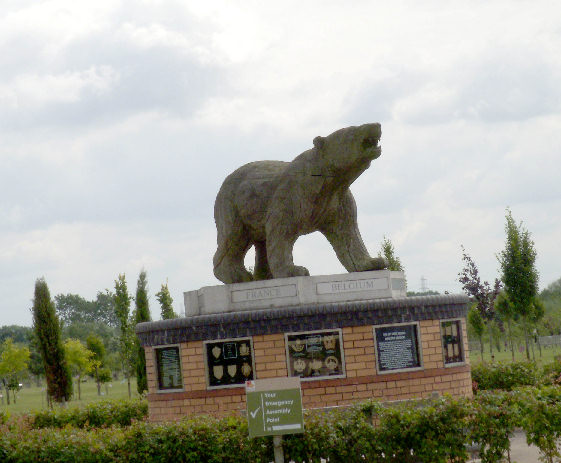October Trip
Keep Saturday 1 st October clear for the Museum trip. Roy Pickford has arranged coach hire for a visit to the Bishop’s Palace at Wells. The cost is £13. Can you please contact Roy (01495 213377) or call at the Museum. We need names now in order to confirm the arrangements. The cost covers the coach and entry to the Bishop’s palace.
Media fame
Bishop Street Allotment Society, of whom we have at least one member in the Museum Society (Bernard Hill), featured in Gardner’s World in the latter part of August. The allotments clearly made a big impression on the production team. Well done!
We recently mentioned that Vice-President Mr Arthur Lewis would be appearing in a history programme with Melvyn Bragg – that will be broadcast on Wednesday 7 th September at 6.30pm on BBC2. Mr Lewis will be talking about coal mining so it is sure to be of interest.
Thank you Biffaward!
You may remember that Biffaward gave us a generous grant towards the café, and then again for the pub display which is currently under way. We felt a little cheeky applying yet again for help with funding the new chapel display but once again Biffaward came up trumps. Their generous funding is much appreciated as is the streamlined grant application procedure. The chapel display will be completed later this autumn – call at the Museum for an update.
Coffee morning
We’d like to extend a big thank you to Robin Tranter who entertained us with readings from his own works and those of other poets. It’s a shame more people weren’t there but the summer is always a difficult time with people away. Those who were able to come along certainly enjoyed it!
August fundraising - £297
Diary Dates
Wednesday 7th September – Newport Wetlands
Saturday 1st October - Autumn trip to Wells £13
100 Club – July 2011
No. 34 Jill Phipps £25
No. 35 Jean Cummings £10
No. 74 Ada Howells £5
100 Club - August 2100
No. 68 Wendy West £25
No. 67 Janet Preece £10
No. 45 Mary Roden £5
Poet’s Corner
As a Grandma, Mother, Wife
I’m striving all my life
To find some time for me
Time when I can be
The woman inside
She’s not to be denied.
To line dance in the nude
Or watch videos, a trifle rude.
Dine at the Savoy
Away from the Hoi Polloi
Bathe in bubbles to my neck
I’d be a woman then by heck!
But my freedom’s not to be
It’s “Mum where’s me kit and what’s for tea?”
“Can you mind the kids tonight?”
Yes I’m sure I can it’s quite all right.
While hubby sits with mobile poised
And plans a night out with the boys.
But as time goes by and I recall
The fun and sorrows of it all
I realise that I’ve been blessed
With nothing but the very best.
Life’s experience has set free
The woman who is really me!
Beryl Moragan
(Beryl was an evacuee in Abertillery, staying with Jack & Dilys Humphries). Thank you Beryl!
Last month’s poem was a gentle take on Welsh names and brought a little cheer to at least one reader. Mr Arthur Lewis wrote to tell us of 90 year old Jenny Jones – a Welsh speaking member of South Woodham Ferrars Bereavement Support Group. She fell recently and broke her femur but having had a metal pin inserted she is walking again with a frame and enjoyed the poem when it was read to a recent group meeting. We hope Jenny continues to make a good recovery.
“I’d do anything for a sarsaparilla”
This is an extract from a piece which appears in the Museum’s book “Voices of Abertillery, Aberbeeg and Llanhilleth”.
I remember having a row off my father. He used to buy chocolate. A half-pound block of Cadburys was eight pence ha’penny and you had to get this from a shop down the bottom of Alma Street called Terrot’s shop. The woman there was a widow and she had a son called Bill, who used to play the banjo and I had to go there to patronise them. But when Smith’s in town opened, they had it cheaper at a cut-price – seven pence ha’penny – but with a stick-on label on it. They also had jars of sarsaparilla in Terrot’s and for a ha’penny you could have a glass of this sarsaparilla. So, you’d buy a block of chocolate for seven pence ha’penny, and try and take the label off, so you could have the ha’penny then for a glass of sarsaparilla, with still a ha’penny left over for a couple of aniseed balls!
Book Corner
Lime, Lemon and Sarsparilla: the Italian Community in South Wales 1881 – 1945
By Colin Hughes, published by Seren Press
This book has been described as a wonderful evocation of Italian life in South Wales from the turn of the last century to the post-war years, when the Italian café was central to the social life of many valley towns. This book follows the fortunes of Italian families such as Rabaiotti, Berni, Bracchi, Conti, Fulgoni, Sidoli and many others, and explores their influence on Welsh society.
Martha Jane and Me
By Mavis Nicholson, published by Seren Press
Television interviewer Mavis Nicholson has a humble background and in this book she tells of how, as a girl growing up in the 30s and 40s in a small terraced house in Briton Ferry, she dreaded her friends finding out that she had to share a large feather bed with her grandmother – the flamboyant Martha Jane. This biography describes with humour the daily round of work and play and family life including her grandfather’s drunken exploits. However, Martha Jane looms large throughout and this book tells of, for example, how she surreptiously sold her daughter’s piano and regularly drove her son-in-law to seek exile in his garden shed.
Nantyglo and Blaina – Vale of Iron
In the reign of Henry VIII the English iron industry was located in the Weald of Kent and Sussex, an area which contained all of the materials for the making of iron. Iron ore was available to be mined and could be separated from its earthy attachment by adding local limestone within the furnace and the whole operation was fired by the combustion of charcoal produced from local timber. Charcoal was the only fuel that could be used safely in the furnace without introducing impurities into the metal. A typical furnace required 700-800 trees every year and the resulting deforestation soon alarmed both tenatnts and land owners. The king was attempting to build up the Royal Navy at this time and soon he compelled the ironmasters to cease depleting his foests and seek sites elsewhere.
Land with similar characteristics was found in Monmouthshire and the driving force behind an enterprise in the town of Pontypool was Richard Hanbury of Worcester. The northern Ebbw valley’s first brush with the iron industry occurred on 12 th July 1576 when Richard Hanbury and others succeeded in leasing from the Earl of Pembroke land at Pontymoel, Panteg and Mynyddislwyn and “the right to cut oak and beech trees in a wood adjoining the River Ebbw”. This mountain side land to the west of Llanhilleth is called Coed Glo” (coal wood), the coal being charcoal and it is still largely devoid of trees. The charcoal burners dug flats on the steep slope for firing purposes several of which can still be seen and digging below the turf will reveal charcoal deposits.
One of the greatest innovations pioneered in the Industrial Revolution was the discovery that coal could be converted to coke and could be used instead of charcoal to successfully smelt iron. Coking the coal drove off unwanted impurities but good quality coal was essential and this gave a boost to those areas where such coal could be mined. South Wales was in the forefront of this new investment. The first coke furnace in this area was built at Hirwaun in 1757 followed over the next 25 years by Dowlais, Plymouth, Cyfarthfa, Sirhowy, Beaufort and Penydarren. This development continued along the northern edge of the coalfield and soon included ironworks at Rhymney, Tredegar, Ebbw Vale, Nantyglo and Blaenavon.
The owners of the Blaenavon ironworks were Hill & Co and in 1788 they leased land from the Earl of Abergavenny to establish their ironworks which began producing in 1790. In 1791 they concluded that their leased ground was far too large for them to exploit alone so a partnership was formed with Harford, Partridge & Co to erect an ironworks at Nantyglo which was in production by 1795. In 1811 the Blaenavon partners sold the works to Joseph Bailey and in 1820 a new partner was Crawshay Bailey. The Nantyglo Ironworks now entered a prosperous period and to increase capacity it became necessary to purchase the Beaufort Ironworks so that Bailey’s could become one of the largest suppliers of rails for the home market. The manufacture of rails continued until the Bailey family decided to retire and the works was sold for £4,000,000. This proved to be a good time to sell because by 1874 the boom period was over and the works was closed. The associated collieries were taken over by J Lancaster & Co of Wigan and later a much smaller Nantyglo works was converted to tinplate production.
Between this time and the end of the 19 th century there were a number of ironworks and forges operating in this area in addition to Nantyglo and these included Blaina Ironworks, Cwm Celyn Ironworks, Coalbrookdale Ironworks and Trostrae. The increasing use of steel rather than malleable iron caused a massive rethink in iron industry strategy – should they invest in costly Bessemer steel making technology, convert to tinplate or slowly face closure? By the early 20 th century these decisions had been made and the Blaina, Nantyglo area saw the steady closure of its once prosperous iron industry. The coal industry within the area, which had been a mere adjunct was now developing with its own increasing momentum – but that is another story.
Laurence Hale
The Osmond family?
We have received an email from Dominic Murray who is trying to trace members of the Osmond family. Mr Murray wrote: “I’m doing some research for a friend of mine who knows little of their family history. One thing they do know is that a Thomas OSMOND lived in Cwmtillery in the 1960s, and it was around this time that his wife and daughter were involved in an accident and were sadly killed by a coal/colliery lorry.
I was wondering if anybody at the museum knew of any newspapers that may have records of this, or if anyone could remember anything about it (especially names).
If you can help, please contact the Museum, or me (Jen Price 01495 212880) and we’ll see that the details are passed on.
Museum Matters
The National Memorial Arboretum
Peggy and I were fortunate in being able to go on a trip with the Abertillery Branch of the Royal British Legion to The National  Memorial Arboretum. The National Memorial Arboretum was conceived as a living tribute to the war time generations of the twentieth century and as a gift to their memory for future generations to reflect upon and enjoy. From the start it was seen as a place of joy where the lives of people would be remembered by living trees that would grow and mature in a world at peace.
Memorial Arboretum. The National Memorial Arboretum was conceived as a living tribute to the war time generations of the twentieth century and as a gift to their memory for future generations to reflect upon and enjoy. From the start it was seen as a place of joy where the lives of people would be remembered by living trees that would grow and mature in a world at peace.
Although still a 'young' arboretum, there are already in excess of 50,000 trees on the site which are a continually growing, living tribute to the fallen.
The site covers an area of 150acres with over 200 significant memorials and gardens which are continually being added to. Peggy and I took the land train; this travels around the site during which a commentary is given. I advise anyone who has not been before to make this their first objective.
There are four coloured walks around the site, BLUE, YELLOW ORANGE and PINK; each walk has its own particular memorials dedicated to various armed forces and civilian organisations.
These surround the Armed Forces Memorial dedicated to all the men and women of our Armed and Merchant Services who have lost their lives in conflict, as a result of terrorist action or on training exercises since the end of the Second World War. During this period the men and women of the Armed and Merchant Services have taken part in more than 50 operations and conflicts across the world, often as part of United Nations, NATO or other international coalitions. These actions have ranged from hot war to peacekeeping; from humanitarian assistance to fighting terrorism; from the jungles of Malaysia to the storms of the South Atlantic; from the streets of Aden to the streets of Northern Ireland. It is a stunning piece of architecture designed by Liam O'Connor and draws its inspiration from the ancient landscapes of prehistoric Britain and the classical forms of ancient Rome. It consists large 6 metre high earth mound; 100 metres wide at the base reducing to just 50 metres wide at the top, which is based on early British barrows or tumuli. It is reached by the spiralling walkway up the grassy, tree-planted slopes and provides accessibility to people of all ages and mobility. At the top of the mound stands a 43 metre diameter stone structure, comprising two curved walls and two straight walls which are constructed of 200,000 bricks faced with Portland stone panels. The centrepiece is two bronze sculptures representing, “loss and sacrifice”. There is a slot in one wall through which at certain times the sun shines through and illuminates the sculpture.
 On the site is the Millennium Chapel of Peace and Forgiveness. It is a wooden construction representing early churches of 1700. Supported on twelve trunks of Douglass Fir’s, representing the twelve apostles. Each column has a carving of an apostle on it. Every item in the chapel has a significant reason.
On the site is the Millennium Chapel of Peace and Forgiveness. It is a wooden construction representing early churches of 1700. Supported on twelve trunks of Douglass Fir’s, representing the twelve apostles. Each column has a carving of an apostle on it. Every item in the chapel has a significant reason.
The FEPOW ( Far East Prisoners of War) Memorial
Commemorates those who were taken prisoner in the Far East. The building is in the shape of the huts in which they were housed, the original Lych Gate from Changi Jail is nearby and also a stretch of original rail from the Burma/Thai Railway which the prisoners were forced to build.
The Gallipoli Monument
 Made an impression on Peggy and me. It includes a tree sculpture of dead oak trees pollarded to represent the arms and hands of injured soldiers reaching upward in the hope of rescue as they lay in the mud among the unburied dead.
Made an impression on Peggy and me. It includes a tree sculpture of dead oak trees pollarded to represent the arms and hands of injured soldiers reaching upward in the hope of rescue as they lay in the mud among the unburied dead.
The Royal British Legion Avenue is a 200m avenue lined with tall English oaks. Poppy seed has been sown between them and as the oaks grow will give a dramatic effect, especially when the poppy’s bloom in May and June each year.
POLAR BEAR MEMORIAL
49 th infantry west riding Division. Stationed in Iceland WWII, known as the Polar Bears It became their mascot.

 What remains in almost everyone’s mind are the walls that are blank, still waiting for the names of future casualties; it leaves one meditating on the cost of our freedom!
What remains in almost everyone’s mind are the walls that are blank, still waiting for the names of future casualties; it leaves one meditating on the cost of our freedom!
Don Bearcroft
